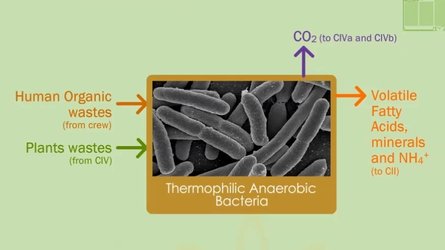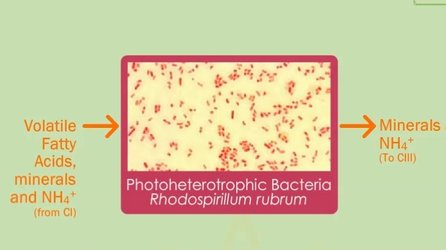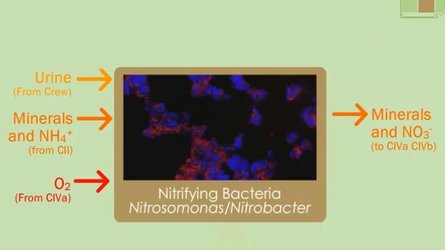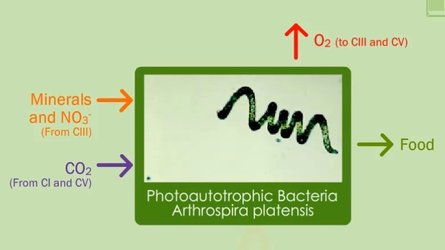Compartment IV : The photoautotophic compartment
The fourth compartment is split into two parts:
- the ‘Algae’ compartment colonised by the cyanobacteria Arthrospira platensis
- the Higher Plant (HP): plants that have lignin material to conduct water and minerals throughout the plant
These two compartments are essential for the regeneration of oxygen and the production of food.
The ‘algae’ compartment (IVa)
The specific cyanobacteria A. platensis colonizes this compartment for several reasons:
- well known acceptance for human diet
- high protein content
- high pH in culture medium lowers the risk of contamination
A. platensis has been extensively studied in the MELiSSA project, stoichiometries have been validated in optimal and several limiting conditions. Several photo bioreactors have been built to support investigations in the MELiSSA pilot plant and a predictive model validated during continuous experiments.


Access the video
The higher plant compartment (HPC IVb)
This compartment must not provide only food and oxygen but also supplies potable water.
The activities on this compartment have been initiated with 8 crops:
- wheat
- tomato
- potato
- soybean
- rice
- spinach
- onion
- lettuce


Access the video
Simulations of this HPC require a description of biomass production rates as well as their mineral and proximate compositions.
Several investigations have been initiated to obtain these values:
- data from open-field data, greenhouses and finally fully controlled environment conditions
- environmental considerations (light, nutrients, vapour pressure,…) are taken into account
- engineering of metabolic chambers for profound investigation of higher plants (e.g. light spectrum and nutrition impact on plant metabolism and development)
The interdependence of metabolic pathways and reactions on environmental parameters need to deeply investigated for each of the selected crops. Also the processing of the food requires extended study as can be found in Phase I.














 Germany
Germany
 Austria
Austria
 Belgium
Belgium
 Denmark
Denmark
 Spain
Spain
 Estonia
Estonia
 Finland
Finland
 France
France
 Greece
Greece
 Hungary
Hungary
 Ireland
Ireland
 Italy
Italy
 Luxembourg
Luxembourg
 Norway
Norway
 The Netherlands
The Netherlands
 Poland
Poland
 Portugal
Portugal
 Czechia
Czechia
 Romania
Romania
 United Kingdom
United Kingdom
 Slovenia
Slovenia
 Sweden
Sweden
 Switzerland
Switzerland





























